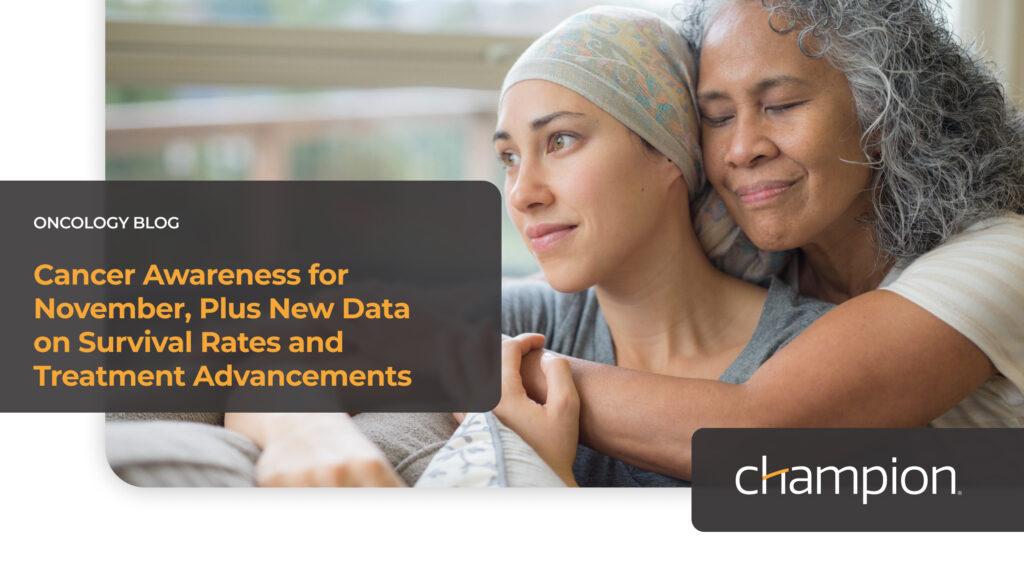
Cancer Awareness for November, Plus New Data on Survival Rates and Treatment Advancements
An insidious disease, “cancer” is the diagnosis given when cells in the body divide uncontrollably, destroy body tissue, and, if unstopped, spread to other parts of the body. The month of November is dedicated to several cancer awareness initiatives.
All of November is dedicated to raising awareness about lung cancer, its risk factors, and the importance of early detection. This month also focuses on raising awareness about pancreatic cancer, a particularly aggressive and hard-to-detect cancer. Finally, November also brings attention to neuroendocrine tumors, including carcinoid tumors.
While not specific to cancer, November also highlights the critical role that family caregivers play in the lives of cancer patients. These dates and initiatives are crucial for increasing public knowledge, supporting research, and encouraging early detection and treatment.
This blog examines current statistics for each of these cancers, as well as recent treatment advancements, and what you can do to help raise awareness.

Sign up to get the latest industry news and offers right in your inbox
Recent Statistics for Lung Cancer, Pancreatic Cancer, and Carcinoid Cancer
Here are the most recent statistics and mortality rates for lung cancer, pancreatic cancer, carcinoid cancer, and neuroendocrine tumors (NETs) in the United States.
Lung Cancer
- Incidence: Lung cancer remains the third most common cancer in the U.S. In 2024, it is expected to account for about 224,000 new cases.
- Mortality: Lung cancer is the leading cause of cancer death in the U.S., with an estimated 118,000 deaths projected for 2024. It is responsible for more deaths than breast, prostate, and colon cancers combined.
- Survival: The 5-year survival rate is about 24%, but this varies significantly based on the stage at diagnosis.
Pancreatic Cancer
- Incidence: Approximately 66,440 new cases of pancreatic cancer are expected in 2024.
- Mortality: It remains the third-leading cause of cancer deaths, with 51,750 deaths projected. It is on track to become the second-leading cause of cancer deaths by 2030.
- Survival: The 5-year survival rate has improved to 13%, up from 6% a decade ago. However, survival rates are significantly lower for patients diagnosed with metastatic disease.
Carcinoid Cancer & Neuroendocrine Tumors (NETs)
- Incidence: NETs, including carcinoid tumors, have been rising in incidence, with about 12,000 new cases annually in the U.S.
- Mortality: While the overall survival rate has improved due to advances in treatment, the prognosis depends heavily on the tumor location and whether the disease is metastatic.
- Survival: The survival rate for localized NETs can exceed 80%, but it drops substantially for metastatic cases.
Read More: “Cancer Facts & Figures 2024”
Read More: “Cancer Statistics 2024” – CA: A Cancer Journal for Clinicians
These cancers pose significant challenges, with lung and pancreatic cancers continuing to lead in mortality despite advancements in early detection and treatment. However, we can’t — and won’t — give up hope. Awareness brings research, and research brings scientific advancements, and those can bring effective treatments for patients.
![]()
Recent Advancements in Treatments for Lung, Pancreatic, and Carcinoid Cancers
Recent advancements in treatments for lung, pancreatic, and carcinoid cancers have been promising, offering new hope for patients.
Advancements in Treating Lung Cancer: Sotorasib (Lumakras™) is an innovative treatment targeting KRAS-G12C mutations, which are common in non-small cell lung cancers. Originally approved for advanced lung cancer, recent clinical trials have shown that combining sotorasib with traditional chemotherapy (carboplatin and pemetrexed) may enhance effectiveness as a first-line treatment. This combination demonstrated a high response rate, with 65% of previously untreated patients seeing tumor shrinkage and improved progression-free survival
Liquid biopsy technology has also emerged, allowing for the detection of circulating tumor DNA (ctDNA) in the blood. This method could improve early detection and monitor treatment effectiveness by identifying residual cancer cells after surgery.
Pancreatic Cancer: The NALIRIFOX regimen, a combination of liposomal irinotecan, 5-FU, leucovorin, and oxaliplatin, was recently approved as a first-line treatment for metastatic pancreatic cancer. This regimen offers improved survival over existing treatments, with a median survival of 11.1 months compared to 9.2 months with the older gemcitabine-nab-paclitaxel combination. NALIRIFOX was also well tolerated, with most patients able to stay on the treatment longer.
Carcinoid and Neuroendocrine Tumors: While specific treatment breakthroughs for carcinoid tumors have not been not highlighted, recent research into neuroendocrine tumors has focused on targeted therapies and immunotherapy. Combining multiple treatment modalities, including surgery, radiation, and peptide receptor radionuclide therapy (PRRT), continues to improve outcomes. Further innovations in this area, such as new somatostatin analogs, are under clinical investigation.
These advancements signify crucial steps forward in improving survival and quality of life for cancer patients.
How Can You and Your Company Participate in Awareness Months?
For your local healthcare organization or medical supply company, November’s cancer awareness dates provide an excellent opportunity to engage in impactful community outreach and support.
Here are several ways you and/or your company can participate.
- Host Free Screenings or Educational Seminars
- Lung Cancer Awareness: Organize lung cancer screening events or partner with local clinics to provide low-dose CT scans. You could also host seminars on the importance of early detection, smoking cessation, and managing air quality.
- Pancreatic Cancer Awareness: Since early detection is rare, hold informational sessions on risk factors and symptoms, as well as the latest treatment options.
- Fundraising Events: Organize charity events, such as walks, runs, or virtual challenges, to raise funds for cancer research or local patient support groups. You could also create donation campaigns in-store or online, with proceeds going to organizations focused on lung, pancreatic, or neuroendocrine cancers.
- Supply Donations: If you are a medical supply company, consider donating medical supplies or equipment (such as personal protective equipment, diagnostic tools, or comfort items) to local cancer centers or oncology units, particularly for patients undergoing long treatments.
- Collaborate with Local Media: Raise awareness by creating and sharing educational content on social media, local news outlets, and blogs. Highlight survivor stories, current treatment advancements, and ways the community can get involved. You can also spotlight healthcare professionals who contribute to cancer care.
- Support Caregivers: November is also National Family Caregivers Month. Offer free workshops or create support packages for family members and caregivers of cancer patients. These could include mental health resources, self-care kits, or caregiver networking groups.
- Offer Cancer Care Kits: Create and distribute care kits for cancer patients, including items such as blankets, skincare products for radiation therapy, or books to help patients pass time during treatment. This can be a community-driven project, where local businesses or individuals can sponsor or contribute to the kits.
- Promote Workplace Giving: Encourage employees to contribute to cancer awareness and support. Set up matching donation programs or volunteer time to support local cancer-related charities or hospitals. Consider offering workplace seminars about cancer prevention, especially in relation to lung and pancreatic cancer.
These efforts can help build awareness, promote early detection, and provide direct support to those impacted by cancer, all while strengthening your organization’s community presence.
We applaud the Champions of Care who work tirelessly in oncology units and research facilities, dedicating their energy and intellect to finding a cure and better treatment options for people diagnosed with cancer.
![]()
What Are the Best Medical Chairs for Oncology Treatments?
Keeping patients comfortable and safe during long oncology treatments is crucial.
Champion’s oncology medical recliners ensure that healthcare professionals have the clinical access and ease of use they need, while creating a comforting and reassuring experience for the patient — and their caregivers.
To view our entire portfolio of products, browse our digital catalog. Then, request a quote for your facility.
